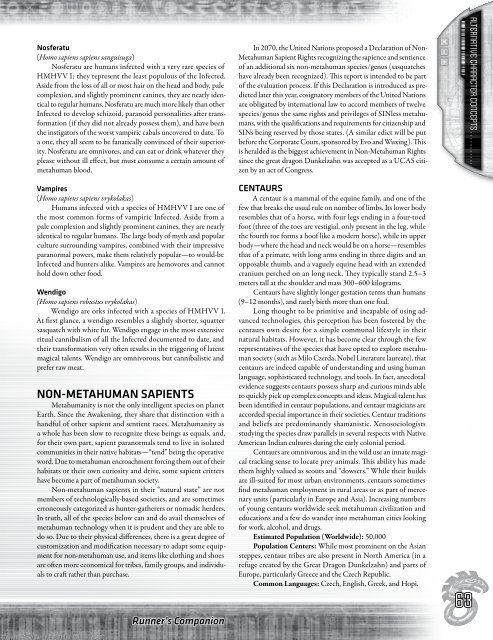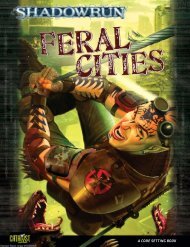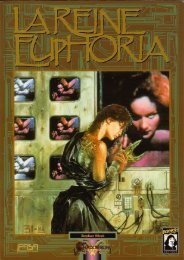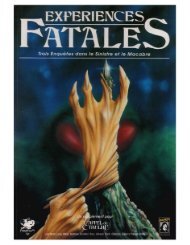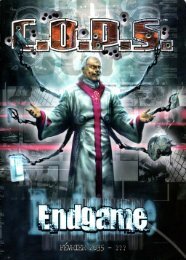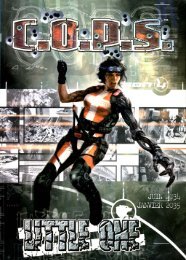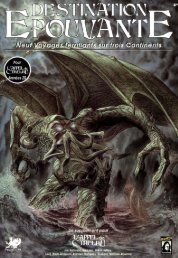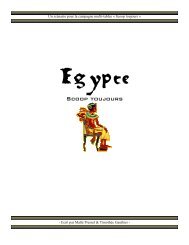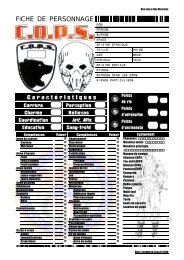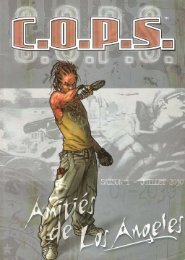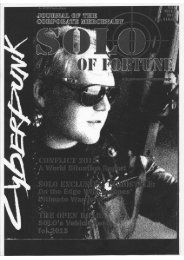Runner's Companion.pdf - Free
Runner's Companion.pdf - Free
Runner's Companion.pdf - Free
- No tags were found...
Create successful ePaper yourself
Turn your PDF publications into a flip-book with our unique Google optimized e-Paper software.
Simon Wentworth (order #1132857) 9Nosferatu(Homo sapiens sapiens sanguisuga)Nosferatu are humans infected with a very rare species ofHMHVV I; they represent the least populous of the Infected.Aside from the loss of all or most hair on the head and body, palecomplexion, and slightly prominent canines, they are nearly identicalto regular humans. Nosferatu are much more likely than otherInfected to develop schizoid, paranoid personalities after transformation(if they did not already possess them), and have beenthe instigators of the worst vampiric cabals uncovered to date. Toa one, they all seem to be fanatically convinced of their superiority.Nosferatu are omnivores, and can eat or drink whatever theyplease without ill effect, but must consume a certain amount ofmetahuman blood.In 2070, the United Nations proposed a Declaration of Non-Metahuman Sapient Rights recognizing the sapience and sentienceof an additional six non-metahuman species/genus (sasquatcheshave already been recognized). This report is intended to be partof the evaluation process. If this Declaration is introduced as predictedlater this year, cosignatory members of the United Nationsare obligated by international law to accord members of twelvespecies/genus the same rights and privileges of SINless metahumans,with the qualifications and requirements for citizenship andSINs being reserved by those states. (A similar edict will be putbefore the Corporate Court, sponsored by Evo and Wuxing). Thisis heralded as the biggest achievement in Non-Metahuman Rightssince the great dragon Dunkelzahn was accepted as a UCAS citizenby an act of Congress.alternative character concepts . . . . . . . . . . .Vampires(Homo sapiens sapiens vrykolakas)Humans infected with a species of HMHVV I are one ofthe most common forms of vampiric Infected. Aside from apale complexion and slightly prominent canines, they are nearlyidentical to regular humans. The large body of myth and popularculture surrounding vampires, combined with their impressiveparanormal powers, make them relatively popular—to would-beInfected and hunters alike. Vampires are hemovores and cannothold down other food.Wendigo(Homo sapiens robustus vrykolakas)Wendigo are orks infected with a species of HMHVV I.At first glance, a wendigo resembles a slightly shorter, squattersasquatch with white fur. Wendigo engage in the most extensiveritual cannibalism of all the Infected documented to date, andtheir transformation very often results in the triggering of latentmagical talents. Wendigo are omnivorous, but cannibalistic andprefer raw meat.non-metahuman sapientsMetahumanity is not the only intelligent species on planetEarth. Since the Awakening, they share that distinction with ahandful of other sapient and sentient races. Metahumanity asa whole has been slow to recognize these beings as equals, and,for their own part, sapient paranormals tend to live in isolatedcommunities in their native habitats—“tend” being the operativeword. Due to metahuman encroachment forcing them out of theirhabitats or their own curiosity and drive, some sapient crittershave become a part of metahuman society.Non-metahuman sapients in their “natural state” are notmembers of technologically-based societies, and are sometimeserroneously categorized as hunter-gatherers or nomadic herders.In truth, all of the species below can and do avail themselves ofmetahuman technology when it is prudent and they are able todo so. Due to their physical differences, there is a great degree ofcustomization and modification necessary to adapt some equipmentfor non-metahuman use, and items like clothing and shoesare often more economical for tribes, family groups, and individualsto craft rather than purchase.Runner’s <strong>Companion</strong>centaursA centaur is a mammal of the equine family, and one of thefew that breaks the usual rule on number of limbs. Its lower bodyresembles that of a horse, with four legs ending in a four-toedfoot (three of the toes are vestigial, only present in the leg, whilethe fourth toe forms a hoof like a modern horse), while its upperbody—where the head and neck would be on a horse—resemblesthat of a primate, with long arms ending in three digits and anopposable thumb, and a vaguely equine head with an extendedcranium perched on an long neck. They typically stand 2.5–3meters tall at the shoulder and mass 300–600 kilograms.Centaurs have slightly longer gestation terms than humans(9–12 months), and rarely birth more than one foal.Long thought to be primitive and incapable of using advancedtechnologies, this perception has been fostered by thecentaurs own desire for a simple communal lifestyle in theirnatural habitats. However, it has become clear through the fewrepresentatives of the species that have opted to explore metahumansociety (such as Milo Czerda, Nobel Literature laureate), thatcentaurs are indeed capable of understanding and using humanlanguage, sophisticated technology, and tools. In fact, anecdotalevidence suggests centaurs possess sharp and curious minds ableto quickly pick up complex concepts and ideas. Magical talent hasbeen identified in centaur populations, and centaur magicians areaccorded special importance in their societies. Centaur traditionsand beliefs are predominantly shamanistic. Xenosociologistsstudying the species draw parallels in several respects with NativeAmerican Indian cultures during the early colonial period.Centaurs are omnivorous, and in the wild use an innate magicaltracking sense to locate prey animals. This ability has madethem highly valued as scouts and “dowsers.” While their buildsare ill-suited for most urban environments, centaurs sometimesfind metahuman employment in rural areas or as part of mercenaryunits (particularly in Europe and Asia). Increasing numbersof young centaurs worldwide seek metahuman civilization andeducations and a few do wander into metahuman cities lookingfor work, alcohol, and drugs.Estimated Population (Worldwide): 50,000Population Centers: While most prominent on the Asiansteppes, centaur tribes are also present in North America (in arefuge created by the Great Dragon Dunkelzahn) and parts ofEurope, particularly Greece and the Czech Republic.Common Languages: Czech, English, Greek, and Hopi.63


